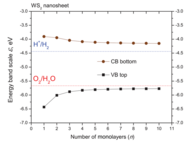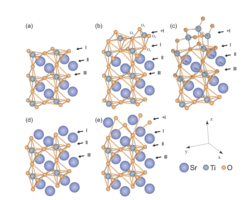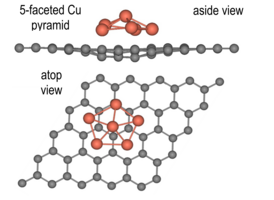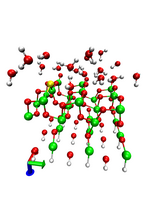Laboratory of Computer Modeling of Electronic Structure of Solids has a strong background in the large-scale first-principles computer simulations on advanced materials, their surfaces, interfaces and nanostructures. Its state-of-the-arts massive parallel computer modelling combines the use of the commercially available first principles quantum mechanical computer codes with the home maid advanced thermodynamic analysis, pair potential approach, molecular dynamics, kinetic Monte Carlo and simpler formalisms. Such an approach allows to obtain reliable atomic and electronic structure of complex advanced materials (nanomaterials), as well as to get the multi-scale picture of physical-chemical processes in a large variety of materials with numerous technological applications.
| Scientific degree | Name Surname | Position | Contact information |
|---|---|---|---|
| Dr.rer.nat. | Sergejs Piskunovs | Head of the laboratory and Leading researcher | Sergejs.Piskunovs 20093610 |
| Dr.phys. | Dmitrijs Bočarovs | Leading researcher | Dmitrijs.Bocarovs 29622457 |
| Dr.phys. | Roberts Eglītis | Leading researcher | Roberts.Eglitis 26426703 |
| Ph.D. | Aleksejs Gopejenko | Leading researcher | Aleksejs.Gopejenko 29558333 |
| Dr.Sci. | Mikhail Brik | Guest Researcher | Mikhail.Brik |
| Bc. | Inta Isakoviča | Research Assistant | Inta.Isakovica |
| Mg. | Elīna Neilande | Research Assistant | Elina.Neilande |
| Jurijs Grečenkovs | Research Assistant | Jurijs.Grecenkovs | |
| Maksims Sokolovs | Research Assistant | Maksims.Sokolovs | |
| Viktorija Vereteņņikova | Laboratory Assistant | Viktorija.Veretennikova | |
| Igors Mihailovs | Laboratory Assistant | Igors.Mihailovs |




- First principles calculations of electronic properties of nanomaterials and heterostructures at nanoscale
- Excited state calculations of hybrid nanostructures for photocatalysis
- Computer modelling of the atomic, electronic and magnetic structure of pristine and defective nanostructured interfaces
- Calculations of surface property of nanostructured ABO3-type perovskites for efficient water splitting
- Calculations of the properties of hybrid metallic-carbon nanotubes
- First principles calculations of charge transfer processes in nanostructured photoelectrodes
- Study of perspective materials to be used in UV photon sensors
- First principles calculations of the vibrational properties of nanostructured materials
- Calculations of the IR and RAMAN spectra for hybrid nanostructures
- Computer simulations of adsorption properties of Cu-decorated graphene in the presence of external electric field
Ab Initio Calculations on the Electronic Structure and Photocatalytic Properties of Two-Dimensional WS2 (0001) Nanolayers of Varying Thickness
The splitting of H2O molecules on semiconducting electrodes under the irradiation of solar light is a clean and renewable way for the generation of hydrogen fuel. Efficiency of photocatalysis in the case of a defectless electrode depends on the relative position of the edges of the bandgap (the top of the valence band and the bottom of the conduction band), which should be properly aligned relatively to the oxidation and reduction potentials separated by 1.23 eV.
In the current study, we have performed hybrid DFT-LCAO calculations of WS2 nanosheets possessing stable hexagonal phase with thickness between 1 and 40 monolayers using hybrid exchange-correlation functional HSE06 adopted for this purpose. Defectless pristine WS2 nanosheets have been found to be suitable for photocatalytic applications since widths of their band gaps correspond to the range of visible light between the red and violet edges (1.5 eV < gap < 2.7 eV) while the top of the valence band and the bottom of the conduction band are properly aligned relative to the oxidation and reduction potentials. We found that the band gap of nanolayers decreases with growing the number of monolayers in layered WS2 2D structure. The highest solar energy conversion efficiency (15–18%) usually achieved for the gap of 2.0–2.2 eV (yellow range of the visible spectrum) has been found for the 2-monolayers thick stoichiometric WS2 (0001) nanosheet. WS2 nanolayers as prospective material for photocatalysis demand no doping or formation of vacancies as in the case of nanostructures of transition metal oxides. Quite the contrary, presence of these defects can worsen photocatalytic suitability of WS2 nanolayers.
Fast-Response Single-Nanowire Photodetector Based on ZnO/WS2
Core/Shell Heterostructures
The surface plays an exceptionally important role in nanoscale materials, exerting a strong influence on their properties. Consequently, even a very thin coating can greatly improve the optoelectronic properties of nanostructures by modifying the light absorption and spatial distribution of charge carriers. To use these advantages, 1D/1D heterostructures of ZnO/WS2 core/shell nanowires with a-fewlayers-thick WS2 shell were fabricated. These heterostructures were thoroughly characterized by scanning and transmission electron microscopy, X-ray diffraction, and Raman spectroscopy. Then, a single-nanowire photoresistive device was assembled by mechanically positioning ZnO/WS2 core/shell nanowires onto gold electrodes inside a scanning electron microscope.
An effective photodetector based on ZnO/WS2 core/shell nanowire is demonstrated
in this work. The photodetector responds to illumination at the wavelengths of 660 nm, 532 nm, and 405 nm. The ZnO/WS2 core/shell nanowire-based device shows a clear advantage over pure ZnO nanowire-based photodetector in terms of both higher responsivity (4.6-fold) and faster operation (90-fold) for 405 nm illumination. The photodetector band diagram was supported by the first principles calculations, suggesting that the interface layer i-WS2, bridging ZnO nanowire surface, and WS2 shell, might play an important role in preventing backward diffusion of charge carriers into the ZnO nanowire, whereas WS2 shell serves as a charge carrier channel in the ZnO/WS2 heterostructure. The obtained results clearly show the potential of combining layeread 2D TMDs materials with semiconducting nanowires to create novel core/shell heterostructures with advanced optoelectronic properties.
Water Adsorption on Clean and Defective Anatase TiO2 (001)
Nanotube Surfaces: A Surface Science Approach
Photocatalytic water splitting is considered as a clean and environmentally responsible way of satisfying global energy demands. For this purpose, the ability of different photocatalysts to drive the water splitting reaction under sunlight illumination has been studied.
Our molecular dynamics simulations show that on the defectfree anatase TiO2 (001) nanotube surface water adsorbs molecularly via weak interactions with the Ti sites and hydrogen bonds to surface oxygens. This binding mode is a consequence of strain-induced curvature effects, as our investigations have shown that neither the nanostructuring by slab thickness reduction nor solvation of thin planar TiO2 (001) films alters the surface chemistry of the partially dissociated contact layer. The water molecules form a relatively strong hydrogen bond network, both for a buckled monolayer and for a multilayer-like (2 ML) film. While doping with sulfur, at the atom fraction (1/18) studied, weakens the interactions between the surface and water, nitrogen doping renders the surface more reactive to water, with a proton transfer to the surface and the formation of an NH group at the N site taking place in every studied case. At 2 ML coverage, even a second surface-assisted proton transfer takes place within the water film, resulting in the formation of an OH− group and an NH2ion on the surface. This effect is present only in the absence of sulfur codoping, due to the generally weaker water−nanotube interactions. The consequences of this behavior for the density of excited states will have to be investigated in a forthcoming publication.
Site symmetry approach applied to the supercell model of MgAl2O4 spinel with oxygen interstitials: Ab initio calculations
Ternary spinel-type AB2O4 oxides known and studied for a rather long time belong to the class of advanced compounds with various electrical, magnetic and optical properties. Spinel-structured magnesium aluminate (MgAl2O4), both single-crystalline and ceramic, characterized by cubic close-packed spatial crystalline morphology, possesses high transparency from visible to infrared wavelength range, enhanced strength and increased melting temperature, excellent chemical and radiation resistance as well as low electrical losses.
The site symmetry approach applied for various configurations of a neutral Oi interstitial per L4 and L8 supercells of MgAl2O4 spinel is based on the group-theoretical analysis of the split Wyckoff positions in the perfect crystal. When performing this analysis, we have compared five possible spatial configurations for inserting oxygen atoms into interstitial positions of a spinel structure. As expected, the interstitial configuration, highest by symmetry in the supercell model, provides the highest formation energy, while arrangement of Oi atoms in less symmetric sites of the spinel lattice is essentially more preferable energetically: values of Eform Oi in the former are found to be 5–6 times larger.
Accomplished projects:
Horizon 2020
CO2-based Electrosynthesis of ethylene oXIDE – CO2EXIDE (2018-2021)
EC Frameworks Projects
EC 7. IP Catherine (2008-2010)
European Social Fund
Experimental and theoretical investigation of technologically important materials (2013-2015)
EUROfusion
Multiscale modelling of radiation effects in MgAl2O4 spinel and general oxides (2014-2020)
Latvian-Ukrainian Bilateral Cooperation Program
Latvian Council of Science
Ab initio calculations of ABO3 perovskite surfaces and defects (2013-2016)
Postdoctoral
National Research Program
National Research Program of Latvia in Materialsciences (2010-2013)
| Year | Number of SCOPUS publications | Number of presentations at conferences |
2015 | 15 (1 chapter in scientific book) | 49 |
2016 | 14 (1 chapter in scientific book) | 36 |
2017 | 17 | 38 |
2018 | 23 (1 scientific book, 1 chapter in scientific book) | 28 |
2019 | 7 | 11 |
Italy:
- Laboratori Nazionali di Frascati (INFN), Frascati (Rome), Italy (Dr. S. Bellucci).
Switzerland:
- Paul Scherrer Institute, Villigen, Switzerland (Dr. M. Krack).
Germany:
- Duisburg-Essen Universität (Theoretische Chemie), Essen, Germany (Prof. Dr. E. Spohr);
- Institut für Angewandte Materialien (KIT), Karlsruhe, Germany (Prof. Dr. A. Möslang).
Jing Wang, M.-Y. Wang, G. Yin, R. Jia, Jian Wang, R.I. Eglitis, H.-X. Zhang. Nickel-catalyzed carboxylation of aryl zinc reagent with CO2: A theoretical and experimental study. Journal of CO2 Utilization, 2019, 29, pp. 262-270.
D. Bocharov, S. Piskunov, Yu.F. Zhukovskii, and R.A. Evarestov, Ab Initio calculations on the electronic structure and photocatalytic properties of two-dimensional WS2 (0001) nanolayers of varying thickness. Phys. Status Solidi RRL, 2018, 12, 1800253 (pp. 1-6).
Yu.F. Zhukovskii, S. Piskunov, O. Lisovski, D. Bocharov, and R.A. Evarestov, Doped 1D nanostructures of transition-metal oxides: first-principles evaluation of photocatalytic suitability (Review). Isr. J. Chem., 2017, 57, p. 461-476.
A. Platonenko, S. Piskunov, D. Bocharov, Yu.F. Zhukovskii, R.A. Evarestov, and S. Bellucci, First-principles calculations on Fe-Pt nanoclusters of various morphologies. - Sci. Rep., 2017, 7, 10579 (p. 1-8).
B. Polyakov, A. Kuzmin, K. Smits, J. Zideluns, E. Butanovs, J. Butikova, S. Vlassov, S. Piskunov, and Yu.F. Zhukovskii, Unexpected epitaxial growth of a few WS2 layers on {11̅00} facets of ZnO nanowires. - J. Phys. Chem. C, 2016, 120, p. 21451−21459.
S. Piskunov, O. Lisovski, J. Begens, D. Bocharov, Yu.F. Zhukovskii, M. Wessel, and E. Spohr, C‑, N‑, S‑, and Fe-doped TiO2 and SrTiO3 nanotubes for visible-light-driven photocatalytic water splitting: Prediction from first principles. - J. Phys. Chem. C, 2015, 119, p. 18686−18696.
S. Piskunov and E. Spohr, SrTiO3 nanotubes with negative strain energy predicted from first principles. - J. Phys. Chem. Lett., 2011, 2, p. 2566–2570.
Yu.F. Zhukovskii, P. Balaya, E.A. Kotomin, and J. Maier, Evidence for interfacial-storage anomaly in nanocomposites for lithium batteries from first-principles simulations. - Phys. Rev. Letters, 2006, 96, 058302 (p. 1-4).
S. Piskunov, E. Heifets, E.A. Kotomin, J. Maier, R.I. Eglitis, and G. Borstel, Hybrid DFT calculations of the atomic and electronic structure for ABO3 perovskite (001) surfaces. – Surf. Sci., 2005, 575, p. 75-88.
S. Piskunov, E. Heifets, R.I. Eglitis, and G. Borstel, Bulk properties of SrTiO3, BaTiO3 and PbTiO3 perovskites: an ab initio HF/DFT study. - Comput. Mater. Sci., 2004, 29, p. 165-178.
Dmitry Bocharov, 5 april 2018. Talks about scientific and PostDoc activities: http://lr4.lsm.lv/lv/raksts/priroda-veschey/smena-paradigmi-sovremennoy-latviyskoy-nauki-teorija-i-praktika.a101981/


